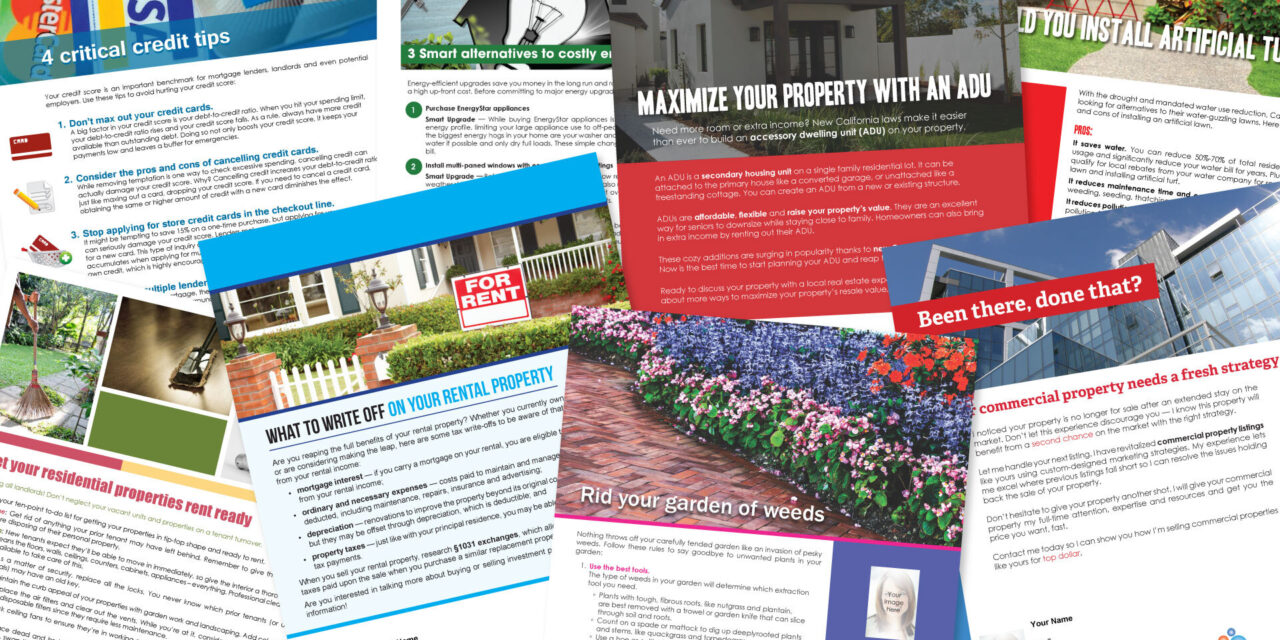 The goal of FARMing is to expand your sphere of influence and develop your brand in the neighborhoods you choose to FARM. For you, it’s primarily about becoming readily recognized by all owners and tenants in each neighborhood, while building a database of branded contacts.
The goal of FARMing is to expand your sphere of influence and develop your brand in the neighborhoods you choose to FARM. For you, it’s primarily about becoming readily recognized by all owners and tenants in each neighborhood, while building a database of branded contacts.
To make a living over the long-term, many contacts are required — some repeat clients, but mostly new. Attaining this level of contacts to generate the needed level of transactions is best analyzed after two to three years of your consistent allocation of time to FARMing.
What to know to knock on doors to build a clientele
One way real estate agents develop and build a clientele is based on soliciting occupants in single family residential (SFR) neighborhoods. But before an agent starts FARMing a targeted community, they need to educate and inform themselves on the applicable rules for door-to-door solicitation, AKA canvassing or door knocking.
An agent uses multiple sources for self-education:
- Discuss with practicing agents who conduct FARMing activities.
- Contact the local governmental agency at city hall overseeing door-to-door solicitation activities about controlling ordinances and any permitting
- Study the local ordinances controlling door to door solicitation to ensure compliance.
The local agency staff will inform you about their ordinances involved, what conduct is prohibited and what permits are required for an agent to solicit door to door. Local rules vary from city to city, and county to county, so you need to study and become the expert in your local practices.
Many cities require real estate agents to carry permits while engaging in door-to-door canvassing. Ordinances often impose restrictions on the hours of solicitation, the types of campaigns allowed and the behavior of the person canvassing neighborhoods.
Although California does not have a statewide requirement to hold a door-to-door solicitation permit, many municipalities require the agent to apply for, pay for and acquire a permit before knocking on a single door.
Permits provide a period of time, say three or twelve months, during which solicitation by the agent acquiring the permit is allowed. On expiration, an application for the issuance of another permit is required to continue door-to-door solicitation. To obtain a permit when required, an agent submits an application on a form provided by the local agency, pays an application fee, and typically provides proof of such things as:
- Livescan fingerprinting
- Employment history
- Criminal background check
- Proof of insurance
Once the physical paperwork evidencing the permit is received, the agent carries the permit and a photo ID while FARMing, whether or not required.
Typically, city ordinances establish the conduct of an agent by stating prohibited activities when visiting residential property, such as the agent may not:
- leave brochures or other materials at an uninhabited or vacant property
- leave brochures in mailboxes, on a car or loose
- physically try to enter against the occupant’s will
- solicit before 8 am or after 7 pm
- misrepresent the purpose of the solicitation
- shout or use any sound device
Agents advertising licensee services need to always include their Department of Real Estate (DRE) license number and their broker’s name on introductory handout materials.
The broker whose agent is embarking on the creation of clientele by canvasing residential neighborhoods also needs to learn the local rules for FARMing. The employing broker has oversight responsibility for their agents who are exercising their right, controlled by ordinances, to develop a brand and conduct business in the community.
Step 1: Find a mentor
Before you begin FARMing on your own, gain some firsthand experience. Team up for a few months with an experienced agent who is a long-time FARMer and not operating in the neighborhoods you intend to FARM. Observe the agent’s operating methods and scripts. You learn by asking questions. Likely, they will be happy to share and introduce you to the basics.
Step 2: Choose your FARM
Choose the neighborhood or community of homes you want to FARM. Your first choice is a location you are already familiar with. Acquire a map of the selected area, choose your routes, set geographic boundaries. City planning departments are most helpful with maps and property information.
How do you decide on the appropriate size for your SFR FARM?
Start with an analysis of your income to set your FARMing goals, based on the:
- number of transactions you need to close each year to attain your personal income objectives
- rate of homeownership turnover in your FARM area
- number of homes you can realistically visit in a day
To determine how many transactions you need each year to make a living, compile a detailed list of your financial requirements, called an income data sheet. [See RPI Form 504]
The fee you receive per transaction varies based on the area you FARM. When your first choice is a neighborhood with little turnover or low-tier home prices, consider commuting to a more profitable area.
Start off by knocking on 50 doors a day. Don’t worry: usually only 20 homeowners out of 50 actually answer the door. This means you knock on doors for two to three hours at most and make around 20 contacts. Keep this up for five days a week until you hit your target number, say 2,000 homes in your FARM.
Then you follow up, repeatedly canvassing the homes in a cycle of every two months until you are so busy with clients you no longer have the time to canvass, just mail. When you need to close more than 20 transactions each year, simply visit more homes each day.
Once you are familiar with your chosen FARM, catalog the status of individual properties on a spreadsheet (distressed appearance, negative or positive equity, mortgage amount or unencumbered, date acquired, price paid, occupant as owner or tenant, mail and email addresses, etc.). This data is knowledge enabling you to adjust your marketing strategy for different categories of homes and occupants.
Step 3: Prepare a script
As a new FARMer, you need to prepare a script to follow in conversations. An effective script includes:
- a proper greeting
- a brief introduction of yourself and your business
- opening questions which normally produce positive responses to set the tone
- answers to common questions you’ll be asked
- a closing
Effective FARMing scripts focus on each unique occupant who answers your knock on the door. Prepare separate scripts addressing services needed by a homeowner considering a sale, and the needs of a tenant interested in buying. Scripts do not focus on yourself.
Canvassing is about building trust and establishing a long-term relationship with homeowners and tenant-occupants.
When a homeowner you visit is interested in selling, be prepared to write up a seller representation agreement, or set an appointment to meet. [See RPI Form 102]
Also, when the occupant is a tenant interested in buying, be ready to enter into a buyer representation agreement. [See RPI Form 103.1]
Most importantly in conversations, listen and respond to what the homeowner or tenant-occupant is talking about. Be grateful for the homeowners’ time and avoid being overly pushy or intrusive. Don’t get caught up in your script to the point of mechanically reciting.
Devote time daily to practicing your script. This routine allows you to internalize the script and make it your own. Once memorized, allow your script to naturally evolve, to keep your conversation from becoming stale and irrelevant, and authentically sounding like you. Politics and religion are no-go zones.
Step 4: Craft your FARM materials
Create a brochure to hand to owners and tenants you make contact with. A brochure increases the likelihood of its being saved for future reference by the homeowner or tenant. So ensure it appears well-designed, full-color trifold and on high-quality paper.
A different brochure is needed for owners and tenants as they have different needs.
The best brochure content is about something significant and enduring regarding a positive event involving the area of your FARM. This causes the homeowner to remember you every time the event is mentioned.
You increase your brochure’s effectiveness when you brag about your recent sales. Establish yourself as the area expert. When you haven’t closed sales in the past few months, consider sharing these alternatives:
- sales made within your office
- local market activity
- practical homeownership tips
Each time you make a contact, harvest their email address in exchange for your brochure or business card. Always ask for the names and emails of people they know who might be interested in buying or selling. Once you have garnered information on a base of contacts, set up an e-mail and direct-mail database.
Email a drip letter once a month to your list of contacts. This email solicitation, as a newsletter, contains information on your recent sales, local market activity or a personalized version of an informational FARM letter.
Depending on the quality of the brochure and flyers you hand out and mail, expect to spend $3,000 – $6,000 a year. Don’t let this amount daunt you — one closed transaction recovers the investment you made to establish your brand.
firsttuesday has a wide collection of personalized FARM letters tailored specifically for mailing to California homeowners and tenants. These brief letters are engineered for use in email and direct mail promotional campaigns, and are free to firsttuesday students and journal readers.
Also, consider forwarding select individuals the link to online articles you read. Your effort demonstrates how you keep yourself, and you contact, technically informed.
FARMing prior clients as a seed to grow future clients
FARMing is not only about making new contacts by visiting SFR occupants. It’s about maintaining supportive relationships with your prior contacts over the years.
Your prior clients are likely curious about what you are doing, so keep in touch as they know who you are. Best of all, clients past and present are your best source of business, some for another transaction but mostly through new clients they influence.
Include in the database of prior clients the days and events they celebrate, such as birthdays and anniversaries. Send cards and text messages on these special days. Consider sending a bulk email to past clients each time you close a transaction. They are glad you are successful, and they talk about it with others.
The key to FARMing success is…
- Consistency: It takes two years to know whether FARMing is working for you, and three-to-five years for FARMing to develop an optimal stream of clients. Mentally grasp the concept that each door knock is an investment which, on average, pays off with future earnings. In the meantime, FARMing is one way you always prospect.
- Persistence: Explore and lean into all possible leads. After every conversation with an owner or tenant, always ask about any neighbors or friends who are considering buying or selling a home. Get their names, and any information. When a referred lead does not answer the door during the week, go back on the weekend.
- Commitment: You will reap what you sow. When you give FARMing or other self-promotion a 50% effort, you get a 50% return rather than what you are capable of developing.
Make a schedule for your FARMing activities and doggedly stick to it. Many agents go into the real estate industry expecting a relaxed schedule and easy money. Agents who do not quickly revise their expectations soon find themselves making a career change.
Ready to get started?
Download and use any of our free 300+ FARM Letter templates as part of your marketing strategy to reach potential clients in your target community.














